Clinical Data
- Home
- Clinical Data
Can a tailored strategy change outcome?
Does stratified medicine guided by an Interventional Diagnostic Procedure (IDP) improve angina in patients without obstructive CAD?
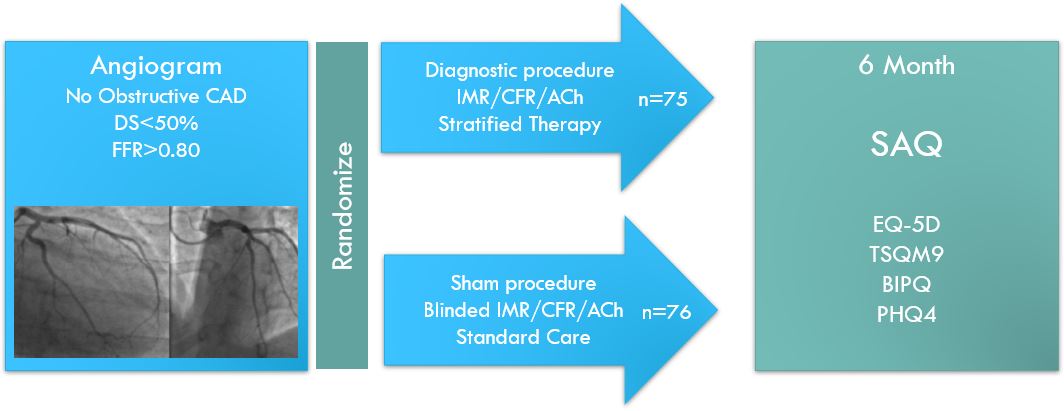
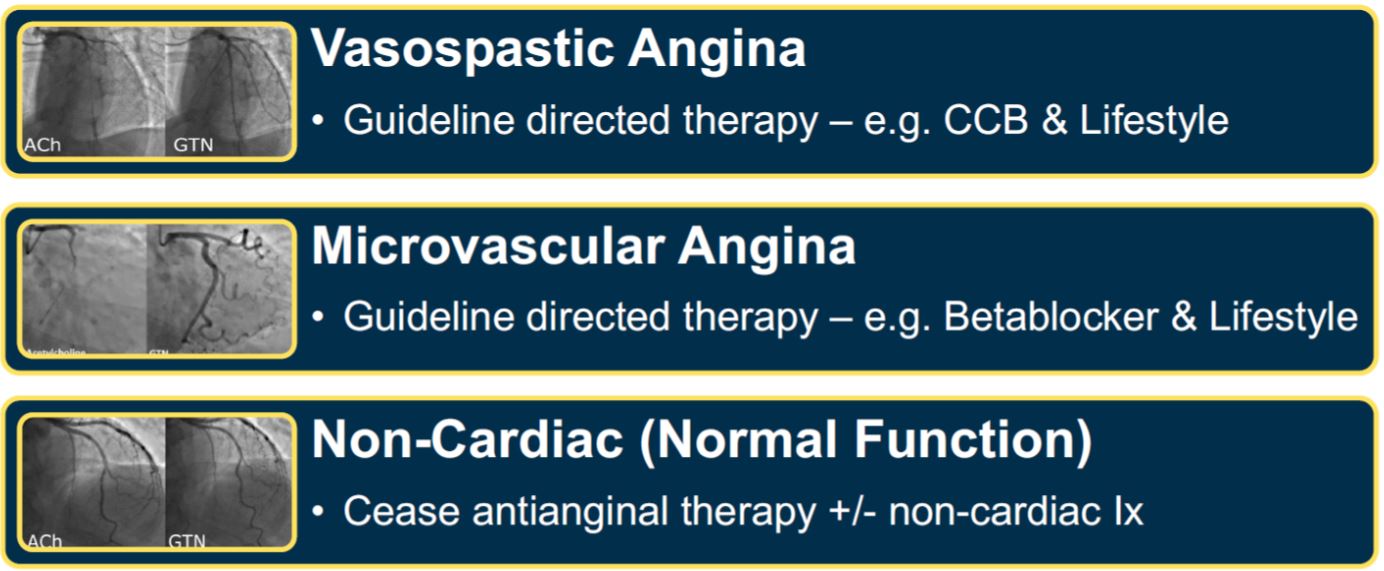
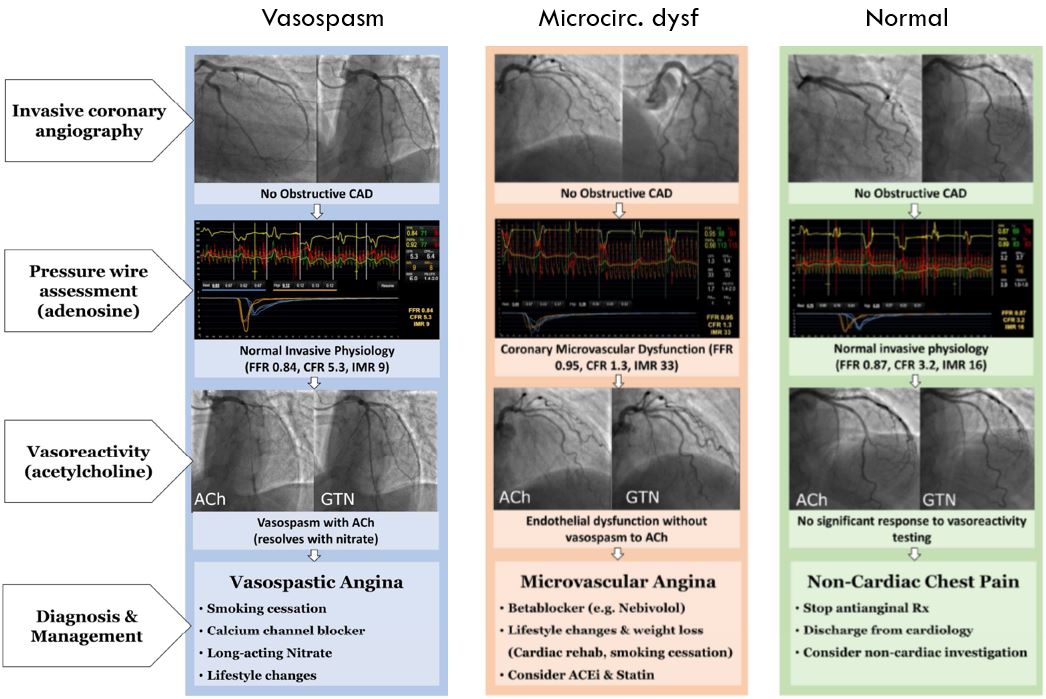
Ford et al, Stratified Medical Therapy Using Invasive Coronary Function Testing In Angina: CorMicA Trial, JACC (2018), doi: https://doi.org/10.1016/j.jacc.2018.09.006.
Primary endpoint: 6-month SAQ change
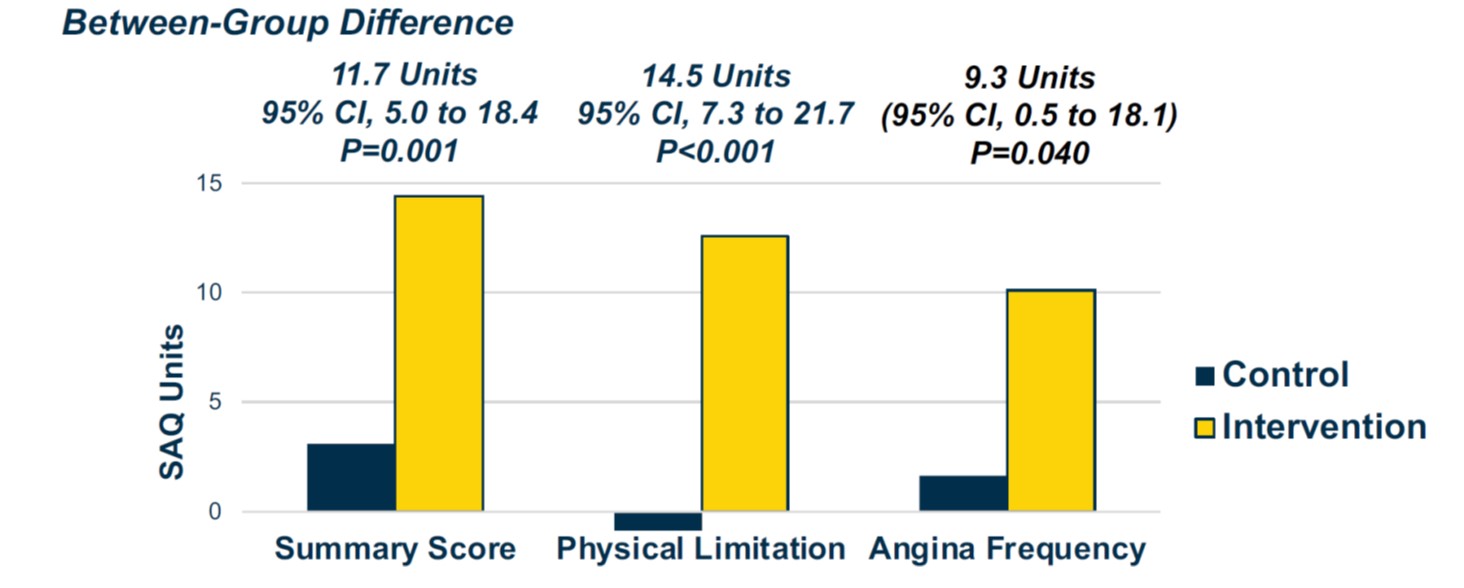
Ford et al, Stratified Medical Therapy Using Invasive Coronary Function Testing In Angina: CorMicA Trial, JACC (2018), doi: https://doi.org/10.1016/j.jacc.2018.09.006.
1 – year outcome
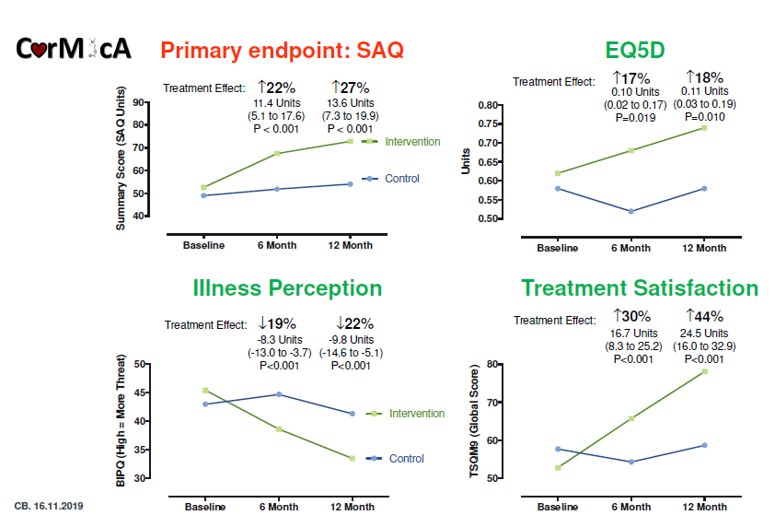
Modified from C. Berry, AHA 2019
ESC Guidelines chronic coronary syndromes 2019 update
Guidewire-based CFR and/or microcirculatory resitance measurements should be considered in patients with persistent symptoms, but coronary arteries that are either angiographically normal or have moderate stenoses with preserved iwFR/FFR.
IIa
6.1.3 Treatment
Treatment of microvascular angina should address the dominant mechanism of microcirculatory dysfunction.
In patients with abnormal CFR <2.0 or IMR >_25 units, and a negative acetylcholine provocation test, beta-blockers, ACE inhibitors, and statins, along with lifestyle changes and weight loss, are indicated.
Patients developing ECG changes and angina in response to acetylcholine testing but without severe epicardial vasoconstriction (all suggestive of microvascular spasm) may be treated like vasospastic angina patients.
The effectiveness of a tailored treatment strategy was investigated in the CorMiCa trial, which randomized 151 patients to a stratified medical treatment (based on the results of CFR, IMR, and acetylcholine testing) vs. a standard-care group (including a sham interventional diagnostic procedure). At 1 year, there was a significant difference in angina scores favouring patients assigned to the stratified medical treatment arm.
References
Prof Nico Pijls, Catharina Hospital Eindhoven, using CoroFlow to assess Absolute Coronary Blood Flow and Myocardial Resistance
Absolute Flow, Resistance and local hypothermia
- Aarnoudse W et al. Direct volumetric blood flow measurement in coronary arteries by thermodilution. J Am Coll Cardiol. 2007 Dec 11;50(24):2294-304. PubMed PMID: 18068038.
- van’t Veer M et al. Continuous infusion thermodilution for assessment of coronary flow: theoretical background and in vitro validation. Med Eng Phys. 2009 Jul;31(6):688-94. doi: 10.1016/j.medengphy.2009.01.006. PubMed PMID: 19237308.
- Wijnbergen I et al. Absolute coronary blood flow measurement and microvascular resistance in ST-elevation myocardial infarction in the acute and subacute phase. Cardiovasc Revasc Med. 2016 Mar;17(2):81-7. doi: 10.1016/j.carrev.2015.12.013. PubMed PMID: 26905054.
- van ‘t Veer M et al. Novel monorail infusion catheter for volumetric coronary blood flow measurement in humans: in vitro validation. EuroIntervention. 2016 Aug 20;12(6):701-7. doi: 10.4244/EIJV12I6A114. PubMed PMID: 27542781.
- Otterspoor LC et al. Safety and feasibility of local myocardial hypothermia. Catheter Cardiovasc Interv. 2016 Apr;87(5):877-83. doi: 10.1002/ccd.26139. PubMed PMID: 26269225.
- De Bruyne et al. Saline-Induced Coronary Hyperemia: Mechanisms and Effects on Left Ventricular Function. Circ Cardiovasc Interv 2017 Apr;10(4). pii: e004719. doi: 10.1161/CIRCINTERVENTIONS.116.004719
Thermo-dilution CFR
- Coronary thermodilution to assess flow reserve: experimental validation. De Bruyne B et al. Circulation. 2001 Oct 23;104(17):2003-6.
- Coronary Thermodilution to Assess Flow Reserve. Validation in Humans. Nico H.J. Pijls et al. Circulation. 2002;105:2482-2486 Originally published May 6, 2002
- Comparison of Coronary Thermodilution and Doppler Velocity for Assessing Coronary Flow Reserve. William F. Fearon et al. Circulation. 2003;108:2198-2200; originally published online October 20, 2003
- Validation of coronary flow reserve measurements by thermodilution in clinical practice. Barbato E et al. Eur Heart J. 2004 Feb;25(3):219-23
Pressure-Bounded CFR, PB-CFR
-
What Can Intracoronary Pressure Tell Us about Flow Reserve? Pressure-Bounded Coronary Flow Reserve and Application to the DEFER Trial. Zimmer et al. Catheter Cardiovasc Interv. 2017 Nov 15;90(6):917-925 DOI: 10.1002/ccd.26972
- What can intracoronary pressure measurements tell us about CFR? Now comes pb-CFR. Nakamura K, Dean LS. Catheter Cardiovasc Interv. 2017 Nov 15;90(6):926-927.
- Fractional flow reserve and pressure- bounded coronary flow reserve to predict outcomes in coronary artery disease, J.M. Ahn et al.European Heart journal/doi:10.1093/ehx139.
-
Coronary Artery disease: physiology and prognosis. Colin Berry et al. European Heart Journal (2017) 0, 1–3
Thermo-dilution IMR
- Novel index for invasively assessing the coronary microcirculation. Fearon et al. Circulation. 2003;107:3129-3132. Originally published July 1, 2003
- Invasive Assessment of the Coronary Microcirculation. Superior Reproducibility and Less Hemodynamic Dependence of Index of Microcirculatory Resistance Compared With Coronary Flow Reserve. Martin K.C et al. Circulation. 2006;113:2054-2061. Originally published May 1, 2006
- Predictive Value of the Index of Microcirculatory Resistance in Patients With ST-Segment Elevation Myocardial Infarction. William F. Fearon et al. J Am Coll Cardiol 2008;51:560–5
- Quantitative assessment of coronary microvascular function in patients with and without epicardial atherosclerosis. Narbeh Melikian et al. Eurointervention 2010;5:939-945
- Microvascular Resistance Predicts Myocardial Salvage and Infarct Characteristics in ST‐Elevation Myocardial Infarction. Alexander R. Payne et al. J Am Heart Assoc. 2012 Aug; 1(4): e002246. Published online 2012 Aug 24. doi: 10.1161/JAHA.112.002246
- Calculation of the Index of Microcirculatory Resistance Without Coronary Wedge Pressure Measurement in the Presence of Epicardial Stenosis. Yong et al. J Am Coll Cardiol Intv 2013;6:53–8
- Prognostic value of IMR after primary percutaneous coronary intervention. Fearon et al Circulation, 2013 Jun 18;127(24):2436-41
- Thermodilution-Derived Coronary Microvascular Resistance and Flow Reserve in Patients With Cardiac Syndrome X. Chufan Luo, Circ Cardiovasc Interv. 2014;7:00-00.
- Review: Invasive Coronary Microcirculation Assessment, Current Status of Index of Microcirculatory Resistance. Yuhei Kobayashi et al. Circ J 2014; 78:1021 – 1028
- Invasive evaluation of patients with angina in the absence of obstructive coronary artery disease. Lee BK et al. Circulation. 2015 Mar 24;131(12):1054-60.